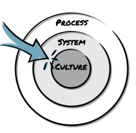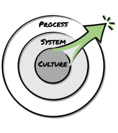Moving to have more a culture with more business agility requires an iterative approach that embeds continuous changes and adapts to what is found. These iterations are usually done as experiments. Experiments are a method to achieve business agility and improve the core practices of your organization. However, doing experiments can have a darker side. In this post, we will look at two types of experiments for new ways of working:
- Experimenting ON people
- Experimenting WITH people

Both cases have appropriate scenarios based on the problem domain. We will use two scenarios to explore a complicated and complex domain.
- Scenario 1 will look at deploying new ways of working using a Complicated Domain approach with experts by Experimenting ON People.
- Scenario 2 will look at how to integrate new ways of working using a Complex Domain by Experimenting WITH people.
Scenario 1: New ways of working from a Complicated Domain Approach
Your organization is looking at new ways of working and wants to start to change the culture to have business agility. You hire experts in the problem space to create the most efficient plan based on your desired change. The change is allocated to these experts to come up with the best ways to work based on the targeted change in behavior (e.g. an Agile Transformation Program). The experts finish their thorough analysis, comes up with some recommendations and your senior leaders sign off.
To ensure someone is accountable, the expert is given the lead role. This expert will roll out the plan to deploy the changes and monitor for adoption (usually in waves or phases that are scaled). Changes to the ways of working will be well communicated and problems identified. If there is resistance, we can mark those people as the ones who “just don’t get it” or need to go to a mandatory training.
Down in the execution phase, the Experts (e.g. External Agile Coaches) start to work with teams and have engaged top management in the new model with status updates and impediments. You seek to have efficiency in having the teams use repeatable practices and work towards the best ways of working. In the event of an issue, the coach can go to the management and outline the employees who are not listening the to the coach’s directives to create alignment.

This is ‘Experimenting ON People’. Experimenting ON people relies on the Expert(s) taking responsibility for the change and driven by pragmatism. This results in a direct approach of re-using agile methodologies where identifying what is wrong and giving instructions to make corrections. The success hinges on forcing compliance with the framework or model for success. This is a Complicated Domain approach because it ignores the agency of people being changed. It assumes that people are replaceable tools like a spanner to be used in the execution of a pre-defined way of working.
In an environment where Expert and/or Achiever Leadership style is dominant, this approach is encouraged as Business Agility can be implemented or deployed. Experimenting ON People aligns with the values of accountability, strategic and benefit oriented by this leadership style. This is an Outside-In approach to change management which usually results in the current systems staying in place while agile approaches are fit to work within the constraints of existing business processes, governance, and policies.

Some examples of Experimenting ON People may include:
- Creating open work space to get people to collaborate (without considering social networks and organizational design)
- Dictating a flat structure to improve communication (and ignoring natural hierarchies)
- Creating agile teams and telling them to do sprints without considering changing the leadership behaviors
- Attempt to standardize processes into a process ‘straight jacket’;
- Keep people in rigid pre-defined roles and responsibilities
- Juggle people between multiple projects and organizations with dotted lines
- Treat the employees’ time and effort as free
Scenario 2: New ways of working from a Complex Domain Approach
In this scenario, you start the goal to have new ways of working from a Complex Adaptive System point of view. This means the domain of the experts is limited. We cannot define the change as a linear plan as each change done will change the system in unexpected ways. You need to look for change opportunities through exaptation. Exaptation occurs through discovery and repurposing your existing capabilities. In this case, we Experiment with the People in the system that we want to change. This is aligned with the Enterprise Change Pattern coming Simon Powers. This model has leaders and people work together in experimenting, not copying what others have done.

Case 2 is about co-creating the future by doing Experiments with People to increment, anticipate and adapt the system. This takes into account the communal knowledge of people who are collectively experiencing the culture. More importantly, the experiments will be unique to the context of the people involved. This is an inside-out approach where business agility is part of the discipline of the culture.

An Inside-Out approach will usually work in steps:
Step 1: Align and focus on the internal values for Business Agility based on a review of the system of work. Leaders learn the values of business agility and how they align to, or conflict with, existing organizational values and culture.
Step 2: They design a System for Agility Agile organizations to not just “do” an agile process. Agile leadership design the and influence the system of work to enable agile ways of working, including structures, policies and measures.
Step 3: Continuous improvement is done through experiments where agile is used as an enabler for a continuously changing destination, not a static state like a framework adoption. The organizational health becomes more about discipline over chasing a framework and operating model. This is a result of ongoing intention and attention by leadership.
Experiment with the People is done through an invitational coaching approach. An invitational coaching approach is based on providing the culture, context and foundations of new ways of working to the team and their leaders together. The goal is to create an environment where the change is owned and co-authored by the people to achieve their agility. This differs from the previous approach where experiments on a team are imposed by an expert, but to let them own their way of working based on principles. This is aligned with creating empowered teams by trusting them to change. An empowered team will know the value they create, the customers they are serving and have the capability to prioritize and limit the number of things they work on in parallel.
So what does this mean?
You can only write experiments for people if they write it themselves.
Simon Powers, Enterprise Agile Bootcamp Class June 2022
Experimenting on people can be done in a complicated problem set. There will be areas where codifying and investing energy in making the problem set repeatable make complete sense. In this case, you can use experts and do experiments on people if you take ownership of the potential ethical dilemmas on imposing a culture on someone.

When we assume that workplace challenges are part of a Complex Adaptive System, we understand that by trying to solve the problems we change the nature of the problem itself. As a corollary to this, an attribute of working in a Complex Adaptive Problems is that the end solution is not predictable at the outset. This is how you avoid the ethical dilemma, by having people co-create the culture, they are part of the solution and not seen as a target for cultural change by force.
2 thoughts on “Are you experimenting ON your people or WITH your people?”